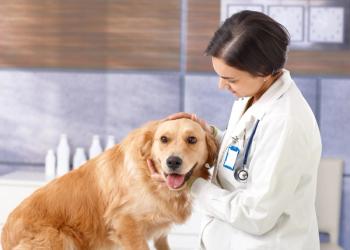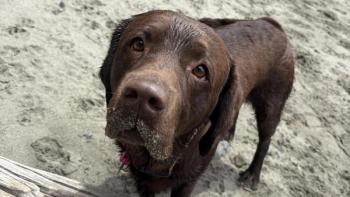
Antibiotic prophylaxis in veterinary chemotherapy: When its worth the risk
Drawing from their evaluation of current standards and practices in human and veterinary medicine, UK researchers make recommendations for infection prevention with antimicrobials in dogs and cats receiving chemotherapy.
For your patients undergoing chemo, infection is often right around the corner. One argument for prophylactic antimicrobial use? Veterinary clients are more likely to pursue chemotherapy when the risk for adverse events is low. (bdavid32/stock.adobe.com)
Due to the immunosuppressive effects of chemotherapeutic drugs, infection is a well-documented adverse event of chemotherapy in human and veterinary medicine. Therefore, patients with cancer are often administered prophylactic antimicrobials, a controversial practice due to the potential development of drug-resistant bacteria.
Veterinary organizations, including the American Veterinary Medical Association and the British Veterinary Association, have created guidelines to help veterinarians practice antimicrobial stewardship.1,2 However, study results suggest that compliance with these recommendations is poor worldwide.3 In a recent study published in Veterinary and Comparative Oncology, a team from the University of Edinburgh Royal School of Veterinary Studies in the United Kingdom reviewed current recommendations and controversial issues surrounding prophylactic antimicrobial use during chemotherapy.4 Their findings and recommendations are summarized here.
Why antimicrobials are recommended
Few veterinary studies have focused on prophylactic antimicrobial use during chemotherapy, and existing research offers mixed results. Therefore, current guidelines draw heavily from human medicine.
Neutropenia is a common adverse effect of chemotherapy. The Veterinary Cooperative Oncology Group classifies an absolute neutrophil count (ANC) below 1.0 x 109/L as clinically significant neutropenia.5 The addition of pyrexia is considered more clinically significant than neutropenia alone and typically warrants prompt administration of empiric broad-spectrum antimicrobials. The estimated incidence of febrile neutropenia in veterinary medicine is about 10%, with certain chemotherapy protocols carrying a higher risk.6 The in-hospital mortality rate for veterinary patients with febrile neutropenia is estimated at 8%.7
In human patients, antimicrobial prophylaxis reportedly reduces rates of febrile neutropenia and hospitalization, thus decreasing overall treatment costs and the likelihood that patients will discontinue chemotherapy due to side effects.8,9 An added benefit in veterinary medicine is that clients are more likely to pursue chemotherapy when the risk for adverse events is low.
Why antibiotic prophylaxis is controversial
Potential concerns with prophylactic antimicrobial use include the development of resistant organisms. Repeated antimicrobial use is documented to increase the proportion of antimicrobial-resistant commensal and pathogenic bacteria in human and animal patients.10,11 Also, disruption of the intestinal microbiome and overgrowth of Clostridium difficile are well documented in human patients undergoing chemotherapy.12 Dysbiosis can alter the patient's immune response and thus may reduce the efficacy of certain chemotherapeutic agents.
Which patients should receive antibiotics?
The National Institute for Health and Care Excellence in the United Kingdom recommends prophylactic antibiotics for human patients who are most at risk for sepsis, such as those receiving high doses or undergoing the first round of chemotherapy.8,13 Similarly, veterinary patients may be more likely to develop febrile neutropenia during the induction phase of chemotherapy. Also, patients with hematologic malignancies, concurrent disease or low body weight are considered at higher risk for febrile neutropenia than other patients.14 Finally, collies and herding breeds possessing the MDR1 gene mutation may have an increased risk of toxicity from certain chemotherapeutic agents, such as vinca alkaloids and doxorubicin.15,16 Therefore, the authors recommend testing at-risk breeds for the MDR1 mutation before administering these drugs.4
Veterinary guidelines typically recommend administering prophylaxis when neutropenia is documented rather than on initiation of chemotherapy. Recommended ANC cutoff values for antimicrobial use range from 0.75 x 109/L to 1.0 x 109/L in veterinary medicine.4,6,17,18 A complete blood cell count is typically obtained one week after administering chemotherapy, as the neutrophil nadir is expected at five to seven days after chemotherapy administration with most drugs. However, the authors emphasize that this value is a “snapshot in time” and instead recommend obtaining a complete blood cell count three days after initiating antimicrobial therapy.4
Many protocols include administering antimicrobials for a standard period of three to seven days based on the anticipated duration of neutropenia. Instead, the authors recommend dosing only until ANC returns above the cutoff value.4 In human studies, increased duration of antimicrobial use (10 to 15 days) resulted in similar mortality and infection recurrence rates as did shorter use (seven to eight days), yet it led to more multiresistant infections.19,20 The authors support the American College of Veterinary Internal Medicine consensus to withdraw prophylaxis when clinical signs and neutropenia resolve and to administer appropriate therapeutic doses of antimicrobials to avoid drug resistance.21
Which antimicrobial to choose?
Bacterial translocation from the gastrointestinal tract is the most common source of infection in patients receiving chemotherapy, and common infection sites include the urinary tract, respiratory tract and skin.4 Although most veterinary texts recommend a combination of intravenous broad-spectrum antimicrobials targeting gram-positive and gram-negative aerobes and anaerobes, current human guidelines advise the use of a single oral or intravenous antimicrobial for patients at low risk for sepsis, a statement supported by the article's authors.22
Fluoroquinolones are often chosen because they offer broad-spectrum coverage while sparing commensal gastrointestinal anaerobes. However, the authors emphasized that fluoroquinolones are listed by the World Health Organization as “critically important for human medicine” due to their role in the development of certain drug-resistant bacteria.23 Overuse of fluoroquinolones is also well-documented in veterinary medicine, and the authors state, “The responsibility for reducing their use and using them only for appropriate clinical indications lies with veterinary clinicians.”4 In recent studies, combination therapy consisting of a quinolone with an antibiotic targeting gram-positive bacteria, such as rifampin or amoxicillin, significantly increased side effects but did not lower mortality rates compared with quinolone therapy alone. Therefore, the authors discourage use of additional gram-positive coverage.4,24
A recently developed drug for neutropenic patients is granulocyte colony-stimulating factor (GCSF), a hematopoietic growth factor. GCSF is reported to reduce the duration of neutropenia in human patients but has not been shown to lower mortality.25 The drug is also expensive, and its use is typically restricted to patients receiving high-risk chemotherapy protocols. Recombinant GCSF is not readily available for animal use, and human GCSF is potentially unsafe for use in animals. Therefore, GCSF remains experimental and is typically administered only in extreme situations, such as cases of chemotherapy overdose.
Conclusion
In closing, the study's authors reiterate that most guidelines for chemotherapy management in veterinary patients are heavily extrapolated from human medicine. This underscores the need for veterinary institutions to increase research efforts toward the relative benefits and risks of using prophylactic antimicrobial agents during chemotherapy.
References
1. Antimicrobial stewardship definition and core principles. American Veterinary Medical Association website.
2. Teale CJ, Moulin G. Prudent use guidelines: a review of existing veterinary guidelines. Rev Sci Tech 2012;31(1):343-354.
3. Knights CB, Mateus A, Baines SJ. Current British veterinary attitudes to the use of perioperative antimicrobials in small animal surgery. Vet Rec 2012;170(25):646.
4. Bisson JL, Argyle DJ, Argyle SA. Antibiotic prophylaxis in veterinary cancer chemotherapy: a review and recommendations. Vet Comp Oncol 2018;16(3):301-310.
5. Veterinary Cooperative Oncology Group-common terminology criteria for adverse events (VCOG-CTCAE) following chemotherapy or biological antineoplastic therapy in dogs and cats v1.1. Vet Comp Oncol 2016;14(4):417-446.
6. Vail DM. Supporting the veterinary cancer patient on chemotherapy: neutropenia and gastrointestinal toxicity. Top Companion Anim Med 2009;24(3):122-129.
7. Britton BM, Kelleher ME, Gregor TP, et al. Evaluation of factors associated with prolonged hospital stay and outcome of febrile neutropenic patients receiving chemotherapy: 70 cases (1997-2010). Vet Comp Oncol 2014;12(4):266-276.
8. Lo N, Cullen M. Antibiotic prophylaxis in chemotherapy-induced neutropenia: time to reconsider. Hematol Oncol 2006;24(3):120-125.
9. Chrischilles EA, Link BK, Scott SD, et al. Factors associated with early termination of CHOP therapy and the impact on survival among patients with chemosensitive intermediate-grade non-Hodgkin's lymphoma. Cancer Control 2003;10(5):396-403.
10. Teillant A, Gandra S, Barter D, et al. Potential burden of antibiotic resistance on surgery and cancer chemotherapy antibiotic prophylaxis in the USA: a literature review and modeling study. Lancet Infect Dis 2015;15(12):1429-1437.
11. Gustafsson I, Sjolund M, Torell E, et al. Bacteria with increased mutation frequency and antibiotic resistance are enriched in the commensal flora of patients with high antibiotic usage. J Antimicrob Chemother 2003;52(4):645-650.
12. Taur Y, Pamer EG. The intestinal microbiota and susceptibility to infection in immunocompromised patients. Curr Opin Infect Dis 2013;26(4):332-337.
13. Klastersky J, Paesmans M, Rubenstein EB, et al. The Multinational Association for Supportive Care in Cancer risk index: a multinational scoring system for identifying low-risk febrile neutropenic cancer patients. J Clin Oncol 2000;18(16):3038-3051.
14. Sorenmo KU, Harwood LP, King LG, et al. Case-control study to evaluate risk factors for the development of sepsis (neutropenia and fever) in dogs receiving chemotherapy. J Am Vet Med Assoc 2010;236(6):650-656.
15. Mealey KL, Fidel J, Gay JM, et al. ABCB1-1Delta polymorphism can predict hematologic toxicity in dogs treated with vincristine. J Vet Intern Med 2008;22(4):996-1000.
16. Mealey KL, Meurs KM. Breed distribution of the ABCB1-1Delta (multidrug sensitivity) polymorphism among dogs undergoing ABCB1 genotyping. J Am Vet Med Assoc 2008;233(6):921-924.
17. Thamm DH, Vail DM. Aftershocks of cancer chemotherapy: managing adverse effects. J Am Anim Hosp Assoc 2007;43(1):1-7.
18. Boudreaux B. Antimicrobial use in the veterinary cancer patient. Vet Clin North Am Small Anim Pract 2014;44(5):883-891.
19. Pugh R, Grant C, Cooke RP. Short-course versus prolonged-course antibiotic therapy for hospital-acquired pneumonia in critically ill adults. Cochrane Database Syst Rev 2015;(8):CD007577.
20. Chotiprasitsakul D, Han JH, Cosgrove SE, et al. Antibacterial Resistance Leadership Group. Comparing the outcomes of adults with Enterobacteriaceae bacteremia receiving short-course versus prolonged-course antibiotic therapy in a multicenter, propensity score-matched cohort. Clin Infect Dis 2017;66(2):172-177.
21. Weese JS, Giguere S, Guardabassi L, et al. ACVIM consensus statement on therapeutic antimicrobial use in animals and antimicrobial resistance. J Vet Intern Med 2015;29(2):487-498.
22. Vidal L, Ben Dor I, Paul M, et al. Oral versus intravenous antibiotic treatment for febrile neutropenia in cancer patients. Cochrane Database Syst Rev 2013;(10):CD003992.
23. World Health Organization. Critically Important Antimicrobials for Human Medicine. 5th rev. Geneva, Switzerland: WHO; 2016.
24. Cruciani M, Malena M, Bosco O, et al. Reappraisal with meta-analysis of the addition of gram-positive prophylaxis to fluoroquinolone in neutropenic patients. J Clin Oncol 2003;21(22):4127-4137.
25. Skoetz N, Bohlius J, Engert A, et al. Prophylactic antibiotics or G(M)-CSF for the prevention of infections and improvement of survival in cancer patients receiving myelotoxic chemotherapy. Cochrane Database Syst Rev 2015;(12):CD007107.
Dr. Stilwell provides freelance medical writing and aquatic veterinary consulting services through her business, Seastar Communications and Consulting. In addition to her DVM obtained from Auburn University, she holds a MS in fisheries and aquatic sciences and a PhD in veterinary medical sciences from the University of Florida.
Newsletter
From exam room tips to practice management insights, get trusted veterinary news delivered straight to your inbox—subscribe to dvm360.






